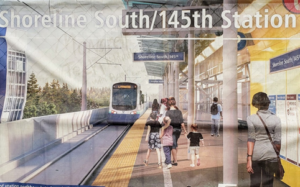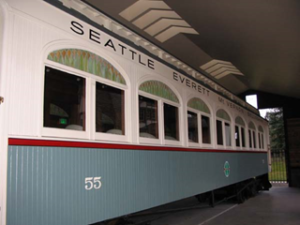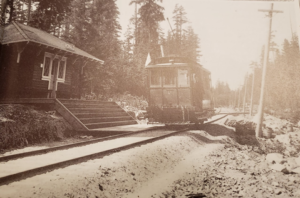A Look Back to the Future: Seattle-Everett Interurban Electric Railway
By Will Murray
A southbound Hammond Car at Ronald Station [Today 175th and Aurora near Ronald Place]. A small car like this ran on 145th to the Seattle Golf and Country Club NW 145th and 3rd NW from 1911 – 1921. Larger Interurban cars ran these tracks from Seattle to Everett 1910-1939 [Courtesy, University of Washington Libraries, Special Collections.]
Courtesy of ‘Seattle by Trolley’ Warren Wing, Lawton Gowey Collection
 A Southbound Siemens-built S70 car Artist concept of Shoreline South/145th Station to be completed 2025 and presently under construction. Courtesy of Sound Transit
A Southbound Siemens-built S70 car Artist concept of Shoreline South/145th Station to be completed 2025 and presently under construction. Courtesy of Sound Transit
At the turn of the 20th Century Broadview residents worked on farms, fishing or in lumber mills and a roundtrip to downtown Seattle was a grueling 8 hour buggy ride. Automobiles were scarce, and trains were plentiful when Seattle commuters were tempted to try the Puget Sound Electric Railway: “Hourly service… Baggage Checked Free… Low Rates.. Fast Time.. No Cinders… No Smoke”. Then in 1910 a commuter could board an electric rail car at 5th and Pike and be whisked sixteen miles north to Forest Park [now Lynnwood] in 45 minutes for 40 cents! The Seattle – Everett Traction Company’s Interurban train cars slowly traversed Westlake and Phinney Ridge until North of 85th St where it reached speeds exceeding 60mph through old growth stands of Doug Fir and tiny communities such as Groveland, Bitter Lake, Ronald and Forest Park. The Interurban Trains running every hour on the hour spurred development of communities and created economic growth carrying market fresh produce, timber and commuters. As highways like State Route 99 were built and upgraded to Expressways they witnessed the rise of the automobile and the demise of Interurban railways nationwide in the early 1940s.
In 2016 Seattle’s car population stood at 637 cars per 1,000 residents totaling 435,000 according to a Seattle Times study and roadways often clogged with traffic. Today many Seattle residents labor over keyboards furthering the Information age. Universities and employers alike provide all access transit passes while many people forgo the expense of automobile ownership. In December of 2000, Sound Transit launched rail service between Seattle and Tacoma and began planning for light rail. Then in 2009 the Central Line was launched with Service between Tukwila and Seattle featuring electric rail cars on elevated tracks. Commuter rail returned to the Seattle area and so did the ridership averaging 80,000 commuters a day in 2009. An extension to Northgate is expected to open in September 2021 and continue onto Lynnwood by 2025. That 40 cent ticket to Lynwood in 1910 will probably be in the $4-$5 range by 2025.
 Take a trip back in time at Lynwood’s Heritage park where Car 55 a 1909 Interurban single-ended wooden electric train car resides. To learn more local history visit: Heritage Park site
Take a trip back in time at Lynwood’s Heritage park where Car 55 a 1909 Interurban single-ended wooden electric train car resides. To learn more local history visit: Heritage Park site

